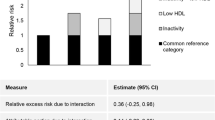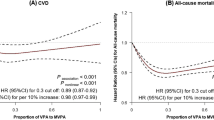Abstract
The study aimed to investigate whether meeting leisure time physical activity recommendations was associated with reduced incident and fatal cancer or cardiovascular disease (CVD) in a community-based cohort of middle- to late-aged adults with long-term follow-up. At baseline, 2,320 individuals were assessed on a large number of lifestyle and clinical parameters including their level of physical activity per week, other risk factors (e.g. smoking and alcohol use) various anthropometric measures, blood tests and medical history. Individuals were linked to hospital and mortality registry data to identify future cancer and cardiovascular events (fatal and non-fatal) out to 15 years of follow-up. Cox regression analyses adjusted for relevant confounders identified a priori were used to estimate risk for all-cause, cancer-specific and CVD-specific mortality. In the full cohort an estimated 21 % decreased risk for all-cause mortality (HR 0.79; 95 % CI 0.66–0.96) and 22 % decreased risk for fatal/non-fatal CVD events (HR 0.78; 95 % CI 0.66–0.92) was associated with baseline self-reported physical activity levels of 150 min or more. After exclusion of those with chronic co-morbidities (CVD, cancer, diabetes, chronic obstructive pulmonary disease, hypertension treatment) at baseline, lower risk for fatal/non-fatal CVD events remained significantly associated with 150 min or more of physical activity (HR 0.77; 95 % CI 0.62–0.96). Results from this well established prospective community-based cohort study support the role of leisure time physical activity in reducing all-cause mortality and CVD events (fatal/nonfatal) in the broader population studied. The data also suggest that physical activity associated reductions in risk for CVD events (fatal/nonfatal) were not overly impacted by prevalent key non-communicable diseases.
Similar content being viewed by others
References
Alwan A. Global status report on noncommunicable diseases 2010. Geneva: World Health Organisation; 2011.
WHO (World Health Organization). Global health risks: mortality and burden of disease attributable to selected major risks. Geneva: World Health Organization; 2009.
WHO (World Health Organization). Global recommendations on physical activity for health. Geneva: World Health Organization; 2010.
AIHW. The Active Australia Survey: a guide and manual for implementing analysis and reporting. In: AIHW cat. no CVD 22. 2003.
US Department of Health and Human Services. 2008 Physical Activity Guidelines for Americans. 2008.
Physical Activity Guidelines Advisory Committee. Physical Activity Guidelines Advisory Committee Report, 2008. In: Services USDoHaH, editor. Washington, DC; 2008.
Williams PT. Dose-response relationship of physical activity to premature and total all-cause and cardiovascular disease mortality in walkers. PLoS One. 2013;8(11):e78777. doi:10.1371/journal.pone.0078777.
Naci H, Ioannidis JPA. Comparative effectiveness of exercise and drug interventions on mortality outcomes: metaepidemiological study. BMJ. 2013;347. doi:10.1136/bmj.f5577.
Meyerhardt JA, Giovannucci EL, Holmes MD, et al. Physical activity and survival after colorectal cancer diagnosis. J Clin Oncol. 2006;24(22):3527–34. doi:10.1200/JCO.2006.06.0855.
Inoue-Choi M, Robien K, Lazovich D. Adherence to the WCRF/AICR guidelines for cancer prevention is associated with lower mortality among older female cancer survivors. Cancer Epidemiol Biomark Prev. 2013;22(5):792–802. doi:10.1158/1055-9965.EPI-13-0054.
Ballard-Barbash R, Friedenreich CM, Courneya KS, Siddiqi SM, McTiernan A, Alfano CM. Physical activity, biomarkers, and disease outcomes in cancer survivors: a systematic review. J Natl Cancer Inst. 2012;104(11):815–40. doi:10.1093/jnci/djs207.
Knuiman MW, Hung J, Divitini ML, Davis TM, Beilby JP. Utility of the metabolic syndrome and its components in the prediction of incident cardiovascular disease: a prospective cohort study. Eur J Cardiovasc Prev Rehabil. 2009;16(2):235–41. doi:10.1097/HJR.0b013e32832955fc.
Holman CD, Bass AJ, Rosman DL, et al. A decade of data linkage in Western Australia: strategic design, applications and benefits of the WA data linkage system. Aust Health Rev. 2008;32(4):766–77.
Byberg L, Melhus H, Gedeborg R, et al. Total mortality after changes in leisure time physical activity in 50 year old men: 35 year follow-up of population based cohort. BMJ. 2009;338:b688.
Samitz G, Egger M, Zwahlen M. Domains of physical activity and all-cause mortality: systematic review and dose-response meta-analysis of cohort studies. Int J Epidemiol. 2011;40(5):1382–400. doi:10.1093/ije/dyr112.
Wen CP, Wai JP, Tsai MK, et al. Minimum amount of physical activity for reduced mortality and extended life expectancy: a prospective cohort study. Lancet. 2011;378(9798):1244–53. doi:10.1016/S0140-6736(11)60749-6.
Moore SC, Patel AV, Matthews CE, et al. Leisure time physical activity of moderate to vigorous intensity and mortality: a large pooled cohort analysis. PLoS Med. 2012;9(11):e1001335. doi:10.1371/journal.pmed.1001335.
ABS (Australian Bureau of Statistics). 4835.0.55.001 Physical activity in Australia: A Snapshot, 2007–08. 2011.
Mok Y, Won S, Kimm H, Nam C, Ohrr H, Jee SH. Physical activity level and risk of death: the severance cohort study. J Epidemiol. 2012;22(6):494–500.
Leitzmann MF, Park Y, Blair A, et al. Physical activity recommendations and decreased risk of mortality. Arch Intern Med. 2007;167(22):2453–60. doi:10.1001/archinte.167.22.2453.
Behrens G, Fischer B, Kohler S, Park Y, Hollenbeck AR, Leitzmann MF. Healthy lifestyle behaviors and decreased risk of mortality in a large prospective study of US women and men. Eur J Epidemiol. 2013;28(5):361–72. doi:10.1007/s10654-013-9796-9.
Finucane P, Giles LC, Withers RT, et al. Exercise profile and subsequent mortality in an elderly Australian population. Aust N Z J Public Health. 1997;21(2):155–8.
Swift DL, Lavie CJ, Johannsen NM, et al. Physical activity, cardiorespiratory fitness, and exercise training in primary and secondary coronary prevention. Circ J. 2013;77(2):281–92.
Anand SS, Islam S, Rosengren A, et al. Risk factors for myocardial infarction in women and men: insights from the INTERHEART study. Eur Heart J. 2008;29(7):932–40. doi:10.1093/eurheartj/ehn018.
Gunnell AS, Einarsdottir K, Galvao DA, et al. Lifestyle factors, medication use and risk for ischaemic heart disease hospitalisation: a longitudinal population-based study. PLoS ONE. 2013;8(10):e77833. doi:10.1371/journal.pone.0077833.
Lee IM, Shiroma EJ, Lobelo F, Puska P, Blair SN, Katzmarzyk PT. Effect of physical inactivity on major non-communicable diseases worldwide: an analysis of burden of disease and life expectancy. Lancet. 2012;380(9838):219–29. doi:10.1016/S0140-6736(12)61031-9.
Yang Q, Cogswell ME, Flanders WD, et al. Trends in cardiovascular health metrics and associations with all-cause and CVD mortality among US adults. JAMA. 2012;307(12):1273–83. doi:10.1001/jama.2012.339.
ABS (Australian Bureau of Statistics) 3303.0 Causes of death, all causes, Western Australia, 2010. (2012). Accessed 16 May 2013.
AIHW. Cardiovascular disease: Australian facts 2011. Canberra: Australian Institute of Health and Welfare; 2011.
Mendis SPP, Norrving B, editors. Global atlas on cardiovascular disease prevention and control. Geneva: World Health Organization; 2011.
Li J, Loerbroks A, Angerer P. Physical activity and risk of cardiovascular disease: what does the new epidemiological evidence show? Curr Opin Cardiol. 2013;28(5):575–83. doi:10.1097/HCO.0b013e328364289c.
Friedenreich CM, Neilson HK, Lynch BM. State of the epidemiological evidence on physical activity and cancer prevention. Eur J Cancer. 2010;46(14):2593–604. doi:10.1016/j.ejca.2010.07.028.
Holmes MD, Chen WY, Feskanich D, Kroenke CH, Colditz GA. Physical activity and survival after breast cancer diagnosis. JAMA. 2005;293(20):2479–86. doi:10.1001/jama.293.20.2479.
Je Y, Jeon JY, Giovannucci EL, Meyerhardt JA. Association between physical activity and mortality in colorectal cancer: a meta-analysis of prospective cohort studies. Int J Cancer. 2013;133(8):1905–13. doi:10.1002/ijc.28208.
Meyerhardt JA, Giovannucci EL, Ogino S, et al. Physical activity and male colorectal cancer survival. Arch Intern Med. 2009;169(22):2102–8. doi:10.1001/archinternmed.2009.412.
Kenfield SA, Stampfer MJ, Giovannucci E, Chan JM. Physical activity and survival after prostate cancer diagnosis in the health professionals follow-up study. J Clin Oncol. 2011;29(6):726–32. doi:10.1200/JCO.2010.31.5226.
Acknowledgments
The 1994/1995 Busselton Health Survey was supported by the Health Promotion Foundation of Western Australia. The construction of the linked data file for this project was supported by Project Grant 404022 from the National Health and Medical Research Council of Australia. The authors acknowledge the Data Linkage Branch of the Western Australian Department of Health for extraction and provision of linked data and thank the Busselton Population Medical Research Institute for permission to use the survey data and the community of Busselton for their long-standing support of the Busselton Health Study.
Conflict of interest
The authors declare no conflict of interest.
Author information
Authors and Affiliations
Corresponding author
Rights and permissions
About this article
Cite this article
Gunnell, A.S., Knuiman, M.W., Divitini, M.L. et al. Leisure time physical activity and long-term cardiovascular and cancer outcomes: the Busselton Health Study. Eur J Epidemiol 29, 851–857 (2014). https://doi.org/10.1007/s10654-014-9963-7
Received:
Accepted:
Published:
Issue Date:
DOI: https://doi.org/10.1007/s10654-014-9963-7




